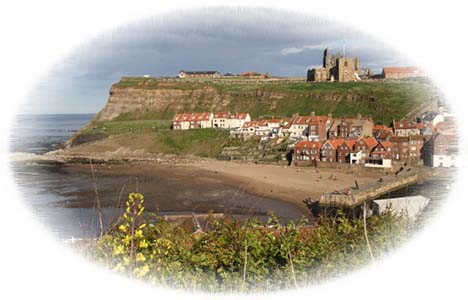Whitby – Jewel of the Coast
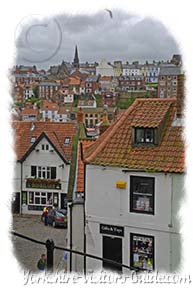
Surely Saint Hilda, who, in the seventh century became the first abbess of Whitby Abbey, could never have imagined that the tiny fishing community clinging to the river bank nearby would grow to become one of the most important sea ports in the whole of England! Indeed, by the time young James Cook, more than a thousand years later, was apprenticed to a collier in Whitby, the port was renowned for its shipbuilding skills, huge fleet of whaling ships and heavy involvement in the bulk transportation of coal around the English coast.
Now, early in the twenty-first century Whitby has been acclaimed “Best Seaside Resort 2006” by consumer magazine “Which? Holiday”. It is, certainly when I was last there in July 2007, bustling with holidaymakers. In places it sometimes feels to be bursting at the seams with happy visitors strolling along the quaysides, laughing, calling out to each other. Exasperated parents chastise over-excited kiddies who are pleading for yet another ice cream or venturing too close to the edge of the quay! Persistent squawks and shrill cries of gigantic, overfed seagulls fill the air with the sounds of the seaside as they wheel overhead or strut disdainfully along the pavements.
Whitby is a popular port of call for many east coast yachtsmen and women and has an active and welcoming sailing club. My wife and I, with our sailing boat “Sunseeker”, rested in the outer harbour for a weekend during our passage northwards along the North Sea coast of England and Scotland some time ago. Although the town is blessed with an extensive and modern marina upriver from the swing bridge, Sunseeker never made it there because we arrived on a Friday evening after the Harbour Master had gone home for the weekend and the bridge was closed to water traffic! I’m sure the situation will be different now, but at the time we were happy to share a berth with the local dredger.
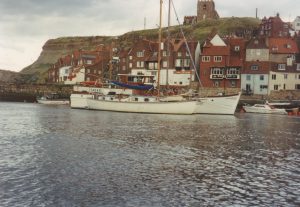
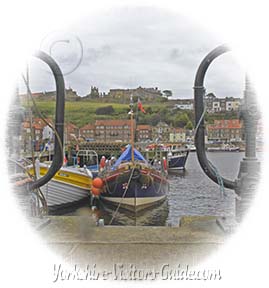
Split in two by the beautiful River Esk on its journey from the North York Moors to the North Sea, the town clings precariously to both sides of the deep valley. There is always something happening in the harbour – the swing bridge constantly opening and closing, allowing access to the sheltered quaysides for fishing boats, pleasure boats and commercial shipping alike. Here you’ll find lots of opportunities to spend time at sea – whether it’s for a trip around the bay in a small replica of Captain Cook’s ship the “Endeavour” or perhaps a sea fishing trip. Don’t forget to bring your “sea legs”!
Beneath the heights of West Cliff the children will enjoy clean, safe sands – time to build sandcastles and bury granddad in the sand while mum and dad rest, soaking up the sun in deck chairs. For the more energetic the beach runs westwards below the cliffs to rock pools – inviting a stroll along the waters edge with shoes in hand and trouser legs rolled up! Some days music may drift across the sands from the harbour-side band-stand as members of a brass band enthusiastically work through their repertoire of rousing tunes.
Whitby Old Town
Across the bridge that connects the two parts of Whitby is where you’ll find the wonderful maze of narrow, cobblestoned streets – part of Old Whitby. Thronging with colourful people, shoppers, trippers and holidaymakers you often need to wait your turn to look in the windows of the tiny shops. With the clamour of shopkeepers and cries of “Ooh – just look at that!” as visitors catch a glimpse inside the glassblowers’ workshops. It all reminds me of Harry Potter’s Diagon Alley (or was it diagonally? – My apologies if you’re not into Harry Potter!). The town is famous for many things – but along these streets and alleyways you’ll find shops displaying and selling the incredibly fragile, blown glass figurines. Here also you’ll be able to buy exquisite jewellery made from the local Whitby Jet. Valued highly by the Romans for fashionable jewellery, jet regained its popularity after Queen Victoria favoured it for mourning jewellery. Before climbing the 199 steps to St Mary’s church and the abbey, consider walking a little further along the street to buy the much acclaimed and delicious Whitby kippers.
Count Dracula
Now – Imagine, if you will, a chill, clammy night. You stand alone on the headland above Whitby. Sea mists creep up from the dark harbour, swirling silently around the tombstones in the silent graveyard of St Mary’s church. The skeletal remains of St Hilda’s ruined abbey reach skyward. The dim lights of Whitby town twinkle behind, ever so near yet far below. And a shiver tingles its way down your spine. A slight breeze wafts away the mist from a headstone and a slab of stone slides soundlessly aside, revealing a dark coffin within. Slowly, ever so slowly, the lid is raised from within. A gasp escapes, unbidden, from your gaping mouth as the tall, slim figure of a man rouses itself from slumber, sleek, jet black hair slicked down. A shiny black cloak covers his shoulders as he steps out onto the damp grass. Silvery light from the full moon, momentarily revealed through the mist, casts a sudden glint of brightness on two long pearly white teeth in the mouth of the ghostly white face …

Yes – it’s easy to understand why author Bram Stoker would choose Whitby as the backdrop for much of his scary Dracula story. As well as visiting the abbey and St Mary’s church you could seek out more details of Dracula and his kind at the Dracula Experience on Marine Parade.
Local Lad Makes Good
Away from fiction now and let’s look at a real life “local lad makes good” story …
- Born to poor parents living on the edge of the moors.
- Apprenticed to a grocer in the tiny fishing village of Staithes nestling between two headlands on the north east coast of England – where he is said to have daydreamed about a life at sea.
- Apprenticed to a collier in Whitby – where he learnt the science (or was it art!) of navigation and seamanship.
Of whom do I speak?
Did you say Captain James Cook RN FRS? – yes? – Well done, you win two points!
The young James Cook learnt his trade of seafarer and navigator as a member of the Merchant Navy aboard humble colliers plying their trade up and down the east coast of England. The home port of the ships he sailed was Whitby and it was during this period of his life that he came to appreciate the incredible seaworthiness and load carrying capacity of these craft.
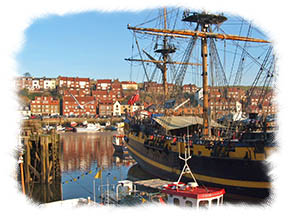
In later life, as he was putting together the ships and equipment for his amazing voyages of exploration, he drew upon this experience when choosing the design of his ships.
He stands today, albeit as a statue atop the West Cliff, gazing out over the wide open sea he loved – but with a weather eye perhaps, to the old Whitby he came to know so well.
Saltwick Bay
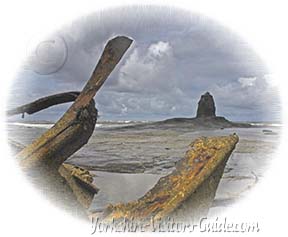
Just along the cliff tops from Whitby Abbey you’ll find the delightful Saltwick Bay with its rather unique rock formation called “Black Nab”. When the tide is in this could very easily be mistaken for the conning tower of a submarine – a bit too close to shore perhaps, but none the less!
Whitby is a friendly, welcoming town. Here you’ll find lots of different places to enjoy fresh, locally caught sea food – from stalls on the quayside, cosy cafes, pubs and restaurants to the big hotels up on West Cliff. Of course other fresh food is available – the choice is yours. Overnight or longer accommodation comes in the form of luxurious hotels through welcoming guest houses and B & Bs to self catering holiday cottages and caravan sites.
